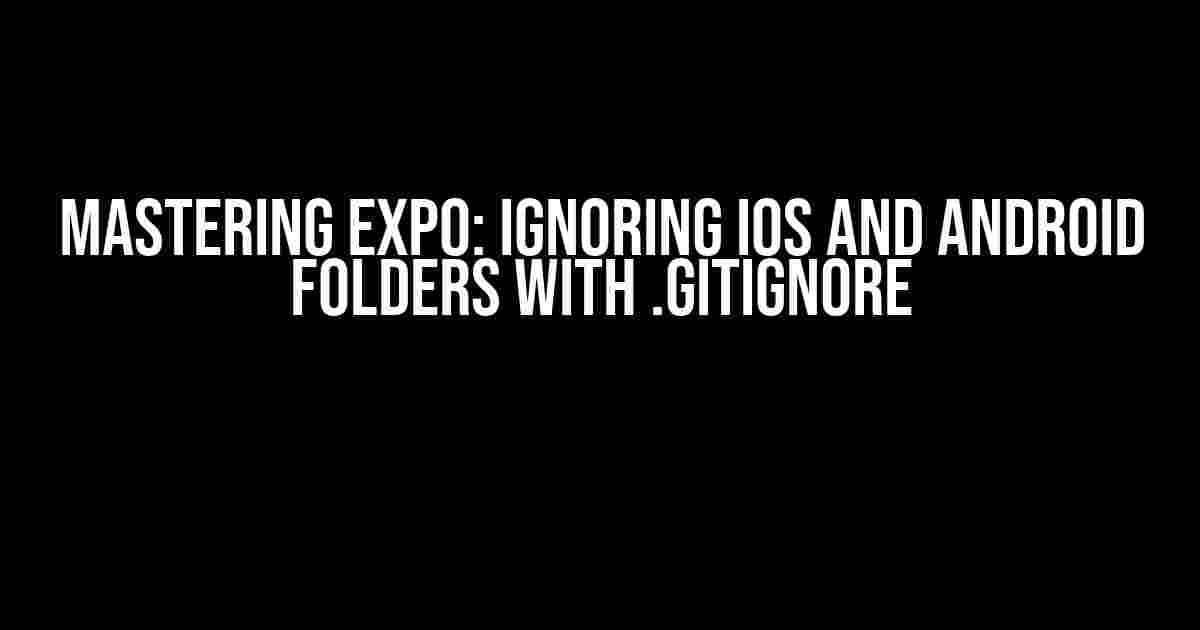As an Expo developer, you know the importance of keeping your project organized and efficient. One crucial aspect of this is managing your Git repository, and that’s where the .gitignore file comes in. In this article, we’ll dive into the world of .gitignore and explore how to ignore iOS and Android folders in your Expo project.
What is .gitignore?
.gitignore is a vital file in your Git repository that tells Git which files and folders to ignore when tracking changes. This file is essential for maintaining a clean and organized repository, as it helps you avoid committing unnecessary files and folders.
Why Do We Need to Ignore iOS and Android Folders?
In an Expo project, the iOS and Android folders contain platform-specific code and generated files. These folders are not essential to the development process, and committing them to your repository can cause issues and bloat your project. By ignoring these folders, you ensure that only the necessary files are tracked and committed.
Creating a .gitignore File
If you’re starting from scratch, create a new file in the root of your project directory and name it `.gitignore`. Yes, that’s a dot at the beginning! This file will contain a list of patterns and file paths that Git will ignore.
# Create a new file in the root of your project directory
touch .gitignore
Ignoring iOS and Android Folders
Now that we have our .gitignore file, let’s add the necessary patterns to ignore the iOS and Android folders.
# Add the following lines to your .gitignore file
# Ignore iOS folder
ios/*
# Ignore Android folder
android/*
# Ignore other unnecessary files
*.iml
*.ipynb
*.log
*.tmp
.DS_Store
Note that we’re using the `*` wildcard to match all files and subfolders within the iOS and Android directories. This ensures that all platform-specific code and generated files are ignored.
Understanding .gitignore Patterns
.gitignore patterns can be tricky, but understanding them is crucial for effective usage.
*: Matches any characters except a slash (/)**: Matches any characters, including slashes (/)?: Matches a single character[abc]: Matches any of the characters within the brackets (a, b, or c)!: Negates the pattern (i.e., matches files that don’t match the pattern)
Using these patterns effectively will help you ignore the right files and folders.
Tips and Tricks
Here are some additional tips to help you master .gitignore:
-
Use the
!character to negate patterns. For example,!*.jswill ignore all JavaScript files except those that match the pattern. -
Use the
/**/pattern to match files and folders recursively. For example,src/**/tempwill ignore all files and folders named “temp” within the “src” directory and its subdirectories. -
Create separate .gitignore files for specific directories or projects. This allows you to tailor your ignores to specific needs.
Expo-Specific .gitignore File
Here’s an example .gitignore file tailored for Expo projects:
# Expo-specific ignores
# Ignore Expo-generated files
.expo/
/node_modules/
bower_components/
*.jsbundle
*.ipa
*.apk
# Ignore iOS folder
ios/*
# Ignore Android folder
android/*
# Ignore other unnecessary files
*.iml
*.ipynb
*.log
*.tmp
.DS_Store
This file ignores Expo-generated files, iOS and Android folders, and other unnecessary files.
Conclusion
Mastering .gitignore is essential for maintaining a clean and efficient Expo project. By ignoring iOS and Android folders, you ensure that your repository remains lightweight and focused on the essential files. Remember to understand .gitignore patterns, use negations and recursive matches, and create separate .gitignore files for specific directories or projects.
Now, go forth and optimize your Expo project with a well-crafted .gitignore file!
| Pattern | Description |
|---|---|
*.js |
Ignores all JavaScript files |
**/temp |
Ignores all files and folders named “temp” recursively |
!*.js |
Ignores all files except JavaScript files |
By following these best practices and understanding .gitignore patterns, you’ll be well on your way to becoming an Expo master!
Here are 5 Questions and Answers about “Expo gitignore ios and android folders” in HTML format:
Frequently Asked Question
Get answers to your burning questions about ignoring iOS and Android folders in Expo projects!
Why should I ignore iOS and Android folders in my Expo project?
You should ignore these folders because they contain platform-specific code generated by Expo, which can be re-generated at any time. Ignoring them prevents unnecessary commits and keeps your Git repository clean.
How do I add iOS and Android folders to my .gitignore file?
Simply add the following lines to your .gitignore file: `ios`, `android`, and `. DS_Store`. This will tell Git to ignore these folders and their contents.
What happens if I don’t ignore these folders?
If you don’t ignore these folders, you may end up committing unnecessary changes, which can lead to conflicts and errors in your project. Additionally, your Git repository will become cluttered with generated code, making it harder to track changes.
Can I still use Expo’s built-in git management if I ignore these folders?
Yes, you can! Expo’s built-in git management will still work as expected, even if you ignore the iOS and Android folders. Expo will continue to generate the necessary code for each platform, and you can still use the `expo commit` command to commit your changes.
Are there any other folders I should ignore in my Expo project?
Yes, you may also want to consider ignoring the `node_modules` folder, as it contains dependencies installed by npm or yarn. Additionally, you can ignore any other folders or files that are generated by Expo or other tools, such as the `.expo` folder.


